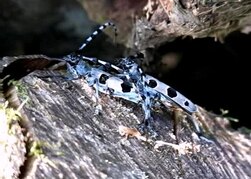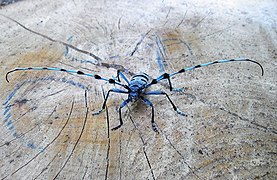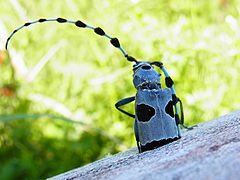Alpine buck
| Alpine buck | ||||||||||||
|---|---|---|---|---|---|---|---|---|---|---|---|---|

Alpine buck ( Rosalia alpina ) |
||||||||||||
| Systematics | ||||||||||||
|
||||||||||||
| Scientific name | ||||||||||||
| Rosalia alpina | ||||||||||||
| ( Linnaeus , 1758) |
The alpine buck ( Rosalia alpina ) is a beetle from the longhorn beetle family (Cerambycidae). Due to its protection at European level, the alpine goat has moved into more general interest. His image appears on postage stamps and as the logo of magazines and nature parks in various countries.
Notes on the name
The first scientific description of the alpine buck was made in 1758 by Linné in the famous 10th edition of his Systema naturae under the name Cerambyx alpinus . At that time Linnaeus only differentiated three longhorn beetles. He puts the genus Necydalis with short-winged species next to the short- winged species , the genus Leptura includes the species whose elytra narrowing towards the rear, the species with parallel elytra he summarizes under the genus Cerambyx and places them in front of Leptura . Linné concludes his description of Cerambyx alpinus with the words Habitat in Helvetia ( Latin: lives in Switzerland). This explains the species name "alpinus" (Latin living in the Alps) and the German name Alpenbock. The occurrence of the species is not limited to high altitudes. Linné also points out older images of the alpine goat.
The generic name Rosalia is a female given name. Mulsant notes that Geoffroy gave Cerambyx alpinus this name. The name is adopted by Serville as a generic name in 1833 .
In Europe, the genus Rosalia is only represented by the alpine buck; six species are assigned to the genus worldwide.
features
With a body length of usually almost three centimeters, the beetle belongs to the larger longhorn beetles, its length varies between 18 and 38 millimeters. The males are on average smaller than the females.
In the male, the antennae protrude far beyond the rear end of the wing cover, in the female they just reach it. On the middle of the eleven antennae segments there are black tufts of hair, in the male on the third to sixth, in the female on the third to eighth member. As a result, the corresponding antenna joints appear thickly black. The compound eyes lie against the deflection point of the antennae from behind and surround it in a kidney shape about halfway.
The pronotum has a blunt spine on both sides and is widest in the middle, slightly wider than the head and significantly narrower than the elytra . These are long and equally wide everywhere and end in a flattened semicircle. The legs are unusually large and strong and allow easy climbing.
The beetle is through his drawing unmistakable. Most of the body appears blue, which is due to very fine and dense hairs that can only be seen when magnified. The color of the hair varies from a deep sky blue to a light gray to a light blue-violet. The parts of the body without hair are velvety black. This color appears on the joints of the legs and antennae, a spot on the pronotum and the markings on the elytra. This elytra-drawing varies extraordinarily. There are typically three spots on each wing cover. The spots in the front third of the wing are on the outer edge of the wing-coverts, those in the rear third of the wing are smaller and are closer to the suture of the wing- cover, the spots in the middle of the wing are fused to form a broad, blunt, jagged band. In the very rare case the animal can be completely blue or completely black.
4 Video: pairing
behavior
The beetles do not appear at higher altitudes until the beginning of July, the males a few days before the females. They show themselves to be happy to fly in good weather at the warm time of the day. The distances on such exploration flights are in the range of one kilometer.
If freshly cut beech logs or firewood fathoms with beech wood are nearby, the beetle will be attracted by them. Otherwise, the sunny lower trunk part of a possible breeding tree is approached. The beetles stay there for a moment, then they crawl around and explore the surrounding area. They choose a control room where they are well camouflaged and have a wide view. There they sit motionless, only the feelers check the air for odors with deliberate movements. Often you can find a beetle in the same position in the same place the following day. A good breeding tree offers space for several areas.
If a competing male approaches, the territory owner rushes towards it and drives it to flight, pursuing the rival to the border of the territory. In case of danger, the beetles flee hastily upwards and escape into the branches, if they are high enough they can also fall, open their wings when they fall and take off. They also drop near the ground and quickly crawl into the litter.
When a female flies towards it, the male approaches and follows the female until she agrees to mate. If the female flies away, the male usually does not follow. Mating takes about an hour. After that, the male stays near the female for some time to fend off other males.
Towards evening and when the weather is bad, the animals withdraw into the treetops or into the hollows of the tree.
The female is usually found alone when laying her eggs. It sits quietly on the wood, only the protruding tip of the abdomen scans the surface for damage to the bark or cracks in the wood. If there is a crack, the laying apparatus penetrates up to 4 cm into the wood or under the bark at the tip of the abdomen. The eggs are usually laid one at a time. The sensors are placed towards the rear. The animal then continues this activity at another location.
The adult beetles are only about 10 days old, according to other sources, three to six weeks. From the middle of August you can only meet a few animals. The eggs are laid in sunny places in the lower trunk area of the breeding tree or, in the case of hollow trunks, inside the trunk, occasionally also in the crown area, but in any case in places where the wood is dying. The larva hatched from the egg continues to eat in the area of the drying wood, later it penetrates the dead wood ( saproxylophagous ). Usually after 3-4 years the feeding tunnel approaches the wood surface again. The larva builds a pupa cradle, gnaws at an exit, then clogs it up again and then pupates. Soon after hatching, the beetle widens the prepared opening into a flat oval, (width: length = 5: 8) 6-11 mm long and 4-8 mm wide and in the direction of the fibers - and squeezes into the open. The bright, characteristic escape hole (Fig. 6 right) is clearly visible in the dark surroundings and is also used to monitor the beetles.
There are contradicting statements about the diet of the adult animal. It shouldn't eat anything at all, or it should gnaw leaves of the breeding tree and drink emerging tree sap, not eat flowers or eat pollen on umbellifers . Possibly these apparent contradictions can be explained by race formation.
- Image 6: Hatching from dead maple
Occurrence
When the name was given in 1758, Linné had material from the Alps, so the Latin name alpina is understandable. The alpine buck occurs on the one hand in the limestone Alps and their foreland. The animals can be found there in the beech belt, i.e. at the altitude at which the beech is the predominant tree species with natural vegetation. This belt is about 1000-1300 m high on southern slopes and lower on northern slopes. In more southern countries, however, the beech can rise higher. That is why the height of the beetle is often over 700 m . The beetles are not found in closed beech forests, however, but on exposed beeches that are clearly damaged ( fragile ) by snow breakage, lightning strikes or falling rocks and that have partially or completely died. The wood of such trees is often blackened by fungal attack. Such trees are more common in heavily grazed mountain regions, as grazing does not allow young forest to emerge. Since the characteristic exit holes are clearly visible on the blackened wood, such beeches are easily recognizable as breeding trees. Exceptionally, other trees are also accepted, most commonly sycamore maple.
It is assumed that the alpine goat as a glacial relic originally had a contiguous distribution area. At the latest during the warming after the last ice age , this area disintegrated into different parts and the beetle was pushed back into the Alps and the cooler peaks of the low mountain ranges. While he was able to move to greater heights in the Alps with the beech belt, this possibility was limited in the other areas of distribution. On the Swabian Alb in southern Germany z. B. the alpine goat occurs in a few places mainly on the steep slopes of the Danube valley . A relic alpine flora can also be found there. Here, too, it develops almost exclusively in fragile beech trees that are exposed to the sun. We encounter the same isolation at high altitudes in the Hungarian mountains. There the alpine goat occurs to the south in the Mecsek , and to the north continuously in the mountain range formed by the Bakony, Vértes, Dunazug, Mátra, Bück and Zemplén. However, the individual trains in the chain are sometimes quite low. The beetle has also been reported from the Szegzárd Hills Nature Reserve , and there the highest point is 285 m. Here, too, the beetle almost exclusively uses exposed and at least partially dying beeches as a breeding tree.
Wood infected with the beetle can reach the plain naturally (landslide, flooding, over watercourses) and the beetle can be transported to new areas. This is no longer an exception in human timber trade. Such displaced animals can even form new populations. Adolf Horion (1974) explains individual finds and temporary settlements in central and northern Germany in this way. Permanent new settlements must adapt to the new environment. In the presence of beech trees, other hardwoods are also used as breeding trees. In a Spanish population , for example, linden trees are specified as (standard) breeding trees. In France, the beetle occurs on the plains, even in wetlands. For example, it is not uncommon in the Marais de Rochefort areas designated in Natura 2000 with a maximum height of 10 m and at the Loire estuary with a maximum elevation of 6 m. There are the breeding trees ash , alder and willow etc. a.
The beetle can be found in many separate populations from sea level to over 1600 m. These areas are located in Spain , France , Italy , the Alpine countries and extend east to Greece , the Black Sea , the southern Urals . The northern border runs through France, southern Germany, Austria , the Czech Republic and Poland . In the south, the beetle is found on Corsica , southern Italy and the Peloponnese , and North Africa is occasionally mentioned . However, the population is falling sharply everywhere. In the past, the alpine buck was also found in Scandinavia, today it is considered extinct there.
Hazard and protection
status
Through the Bern Convention of the Council of Europe, the convention on the conservation of European wild plants and animals and their habitats, the species is protected throughout Europe in accordance with Appendix II. With the implementation of this multinational contract in the general Habitats Directive 92/43 / EEC of the European Union of May 21, 1992, the alpine goat enjoys double and supranational protection:
- in Appendix II it is listed as an animal species of Community interest, for the conservation of which special protection areas must be designated. The Natura 2000 project serves this purpose and is to be understood as a network of protected areas.
- In Appendix IV the alpine buck is listed as a strictly protected species of general interest.
At least in the Alpine countries, the alpine goat has long been under nature protection . B. in Germany since 1936. Today it is protected in all affected countries by the state nature conservation laws.
The hazardous situation is recorded in various red lists . The World Conservation Organization IUCN puts the world population in the 2009 edition of the Red List of Endangered Species in the "Vulnerable" category. In Germany, the species is listed in the Red List of Endangered Species in Germany as well as in Bavaria under category 2 (endangered). In the federal states of Brandenburg , Saxony-Anhalt and Thuringia , it is considered to be extinct or lost .
causes
Five reasons are given for the hazard:
- The females prefer freshly felled trunks and wooden fathers (firewood) for laying eggs. If these are removed and processed, the beetle cannot develop.
- With the currently predominant management (Fig. 10) of the forests, the potential breeding trees are eliminated.
- Former pastures are overgrown and the breeding trees on them become unusable.
- If, as an exception, dead wood remains in a shaded position, the moisture-favored infestation by saprophytes prevents the larvae from developing.
- The females are also attracted by the pheromone traps for bark beetles and are thus prevented from choosing suitable breeding trees for oviposition.
activities
The species can only be preserved in its population through biotope protection .
- The most far-reaching protection would be to restore entire mountain ranges to traditional cultivation with grazing on the peaks. Routes in road construction, agricultural development and the designation of new building areas have to respect the beetle's habitats. The EU directives create significant political pressure here.
- The individual forest owner is advised to limit the removal of wood to periods in which the female cannot cover the felled wood with eggs (September to July), or at least to store it in the shade. Dying trees or upright wood after storm damage should remain in the forest.
- The Swiss Federal Research Institute WSL has found out in a series of tests that vertically erected beech trunks two to three meters high and at least 30 centimeters thick in a sunny location are most likely to be accepted by the females as nesting aids and also lead to breeding success. Any nature conservation association, even farmers or garden owners, could set up such nesting aids as individuals. Of course, this is only possible if there are still alpine bucks in the area or if it is ensured in some other way that the trees are covered with eggs.
literature
- Jiři Zahradnik, Irmgard Jung, Dieter Jung et al .: Käfer Central and Northwestern Europe , Parey Berlin 1985, ISBN 3-490-27118-1
- Bernhard Klausnitzer : Beetle . Nikol Verlagsgesellschaft mbH & Co. KG, Hamburg 2005, ISBN 3-937872-15-9
- Michael Chinery: Parey's Book of Insects. A field guide of European insects. Publishing house Paul Parey, Hamburg u. Berlin 2004, ISBN 3-440-09969-5
- Heinz joy, Karl Wilhelm Harde, Gustav Adolf Lohse (ed.): The beetles of Central Europe . tape 9 . Cerambycidae Chrysomelidae . Spektrum Akademischer Verlag, Munich 1999, ISBN 3-8274-0683-8 (first edition: Goecke & Evers, Krefeld 1966).
- Adolf Horion : Faunistics of the Central European Beetles Volume XII, 1974
- Svatopluk Bily: Coleoptères , Gründ 1991, ISBN 2-7000-1824-9
Individual evidence
- ^ Rosalia alpina in Fauna Europaea. Retrieved September 16, 2011
- ↑ Alpenbock in the logo of the Duna-Ipoly National Park
- ↑ C.Linnaeus: Systema Naturae per Regna tria naturae, secundum classes, ordines, genera, species, cum characteribus, differentiis, synonymis, locis. Tomus I. Editio decima, reformata Stockholm 1758 Genus Page 392 No. 23
- ↑ Sigmund Schenkling: Explanation of the scientific beetle names (species)
- ↑ Sigmund Schenkling: Explanation of the scientific beetle names (genus)
- ^ E. Mulsant: Histoire naturelle des Coléoptères de France Paris 1862–1863 Rosalia p.73
- ↑ M. Audinet-Serville: Nouvelle classification de la famille des Longicornes Annales de la Société entomologique de la France, tome 2, p. 528 ff. In BHL, p. 561
- ^ Rosalia at Fauna Europaea. Retrieved February 28, 2013
- ↑ Species of the genus Rosalia at BioLib
- ↑ a b c d e Peter Duelli, Beat Wermelinger: The alpine goat (Rosalia alpina) A rare longhorn beetle as a flagship species of the Swiss Federal Research Institute WSL Leaflet for Practice 39 2005 ISSN 1422-2876 as PDF
- ↑ State Office for the Environment, Measurements and Nature Conservation Baden-Württemberg: Alpenbock as PDF
- ↑ Find reports in Szegzárd ( Memento of August 24, 2009 in the Internet Archive )
- ↑ Occurrence in the Marais de Rochefort ( Memento from November 23, 2006 in the Internet Archive )
- ^ Locations in Spain
- ↑ Distribution map for France ( Memento from November 26, 2006 in the Internet Archive )
- ↑ Red lists at BioNetworkX
- ↑ Leaflet from the Federal Research Institute
Web links
- Rosalia alpina in the endangered Red List species the IUCN 2009. Posted by: World Conservation Monitoring Center, 1996. Retrieved on January 1st of 2010.















